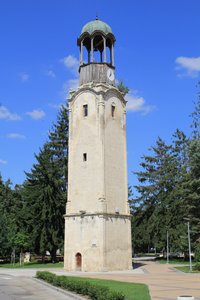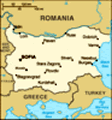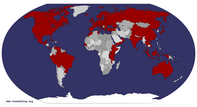Advertisement
Published: October 3rd 2017

 Razgrad clock tower
Razgrad clock tower
Surprisingly, considering that Bulgarians didn't see that city as a place worth visiting, Razgrad was pretty nice and worth spending some time in. Here is the town's clock towerFrom strangely shaped rocks, via 1,000 year old historical sites to a surprise find of a geyser
We are now, just like the title indicates, going to tell you what we did and where we went during our second week in Bulgaria. Before we start writing we would like to point out that just like in the previous blog entry the photos don't come in chronological order. So there is little point in trying to retrace our route.
•
Razgrad - When we told people we met that Razgrad was on our itinerary for this trip they couldn't believe us. They all said that no Bulgarian doing a road trip in their own country would bother to visit Razgrad. We had a special reason, we had booked a half marathon there. It was a small race, only about 250 competitors in all and of those only about 80 did the half marathon.
It was a good and fun race and it was well organised. It was tough because there were lots of hills and some trail running on top of that. But we loved it.
Surprisingly, considering that Bulgarians didn't see that city

 Ibrahim Pasha Mosque
Ibrahim Pasha Mosque
The 16th century Ibrahim Pasha Mosque in Razgradas a place worth visiting, Razgrad was pretty nice and worth spending some time in. Things worth seeing included among other things the mid 19th century clock tower and the 16th century Ibrahim Pasha Mosque.
•
Beli Plast - A small village which would be just as anonymous as hundreds of other similar villages if it wasn't for the unusual Stone Mushrooms. They are, not surprisingly, rocks which look like mushrooms. These rock formations are natural and have probably been created when lake or seawater eroded sedimentary rock.
•
Thracian Tomb of Kazanlak - "The Thracians were a group of Indo-European tribes inhabiting a large area in Eastern and Southeastern Europe". That description we took from Wikipedia. We actually didn't know about the Thracians before we went on this trip. Now we know only a tiny bit more than we did before. We know that there are plenty of historical sites in Bulgaria connected with the Thracians and we know that the name Thracians sounds funny. Or are we the only ones who think "Thracians" almost sounds like "Trashians"?
Thracian Tomb of Kazanlak is a UNESCO world heritage site. You can't visit the

 Stone lion adorning a bridge
Stone lion adorning a bridge
One of the bridges in Razgrad is adorned with this lionactual tomb, it is much too fragile. However, next to the tomb they have built a copy of it which you may enter and roam around in as much as you like as long as you pay the entry fee.
•
Devil's Bridge - Pretty much in the middle of nowhere there is beautiful stone bridge known as Devil's Bridge. The road which led to this place was so small and insignificant that our GPS navigator didn't know about it. When we were about 3 km from the bridge the road deteriorated so badly that we had to park the car and walk the rest. But it was worth it because when we reached the Devil's Bridge we not only found a very picturesque bridge. We also found a green secluded valley, a small clean river, green trees, blue sky and peace and serenity. It was a big mistake to leave the swim suites in the car though. We actually thought about skinny dipping but were afraid that we might scare people if we did.
•
Melnik - supposedly the smallest town in Bulgaria. It is famous for being a centre for wine production

 Coffee machine
Coffee machine
In every town, and even in many villages, they have coffee machines like this. The coffee from them was surprisingly goodand for only permitting houses to be built in the local traditional style giving the town a special character.
•
The Marvellous Bridges - a natural phenomenon where a river has created tunnels or caves through the rocks.
•
Sapareva Banja - this town was not really on our agenda. We ended up here because we needed a place to stay. The town has a claim of fame though, a geyser. Supposedly this geyser is the only one in Bulgaria and it can be seen in a park in the central town. The geyser was created when they drilled a deep borehole and hit a superheated water reservoir deep down in the ground.
•
The Stone Forest - The Stone Forest consists of a large number of stone pillars of various sizes standing in a desert like landscape. This is a natural phenomenon where erosion over maybe more than a hundred thousand years has carved the limestone into these shapes.
•
Pliska Historical City - Just like Sapareva Banja this was a place we stopped at only because we needed accommodation. Our guidebook didn't have a word about

 The Stone Mushrooms
The Stone Mushrooms
The Stone Mushrooms is a natural rock phenomenon near the village Beli PlastPliska so we didn't expect to find anything there apart from the hotel we had booked. To our great surprise we learned that Pliska, now a very small and very discreet village, once was the capitol of Bulgaria. This was back in the 7th to 9th century CE so most of the glory of the past has been lost. Archaeologists and historians have in a combined effort dug up and visualised the remains of palaces, churches and other important buildings from more than 1,000 years ago. Although parts of the restorations look more like reconstructions-from-scratch it was still an interesting place to visit.
•
Pliska Village - Pliska Historical City is located a few kilometres outside Pliska Village. It was obvious to us that Pliska Village has seen better days. If you wish to learn more about why see the text further down on Bulgaria's demography. It was a nice place to go on a stroll in the evening but there really isn't much to see there. But we still would like to upload two photos from Pliska on this blog. The first is a simple mural depicting a woman carrying harvest. We found that on a

 The Stone Mushrooms
The Stone Mushrooms
The area where the Stone Mushrooms are was smaller than we expected. But it was still worth going therewall in the village and it is one of those things that is so fun to find in a place where you least expect it. The second is a photo of a much fainted hammer and sickle. It is the only hammer and sickle symbol we found outside communist monuments and museums.
•
Madara Rider - The Madara Rider is a large rock relief depicting a man on a horse and a dog running next to the horseman. This work of rock art is well over 1,000 years old and is a UNESCO world heritage site. In the vicinity of the Madara Rider there are several other historical remains. There is the ruin of a fortress, there is the foundation of a church and at least two other buildings that once held great importance.
Before we quit we would like to write a bit about Bulgaria's demography. We know that it sounds really boring but by reading a little about that subject you will understand a bit about Bulgaria today. If it feels too damn dull and you can't make yourself read that feel free to quit now and look at the

 Thracian Tomb of Kazanlak
Thracian Tomb of Kazanlak
Thracian Tomb of Kazanlak is a UNESCO world heritage site. You can't visit the actual tomb, which is pictured here, because it is too narrow and much too fragile. rest of the pictures instead because the rest of the text will be about the population of Bulgaria only.
We started to get interested in the demography of Bulgaria after we had travelled there for about a week. We had by then visited a few towns and cities and had noticed that the population of every settlement seemed to have decreased rapidly in recent years. Every town showed signs of having a decreasing population but we couldn't find any city where the population was increasing. When we asked Wikipedia we understood why. In 1989 there were 9 million people living in Bulgaria. In 2015 that number had dropped to less than 7.2 million. That's down 20% in 25 years and that is a lot!
All of a sudden what we saw made a lot of sense. We now understood the reason behind us seeing many abandoned houses and why people everywhere seemed to have a rough time making ends meet.
We are not going to dive too deep into the subject "life in Bulgaria over the last three decades", partly because we don't know much about it and partly because it is not likely to

 Thracian Tomb of Kazanlak
Thracian Tomb of Kazanlak
However, next to the tomb they have built a copy of it which you may enter and roam around in as much as you like as long as you pay the entry fee. Here is a photo from inside the copy of the tombdraw new fans to our blog. But we quickly drew some conclusions from the numbers given above:
• It has been a rough transition for the Bulgarians to go from Communism to a free market and an open society
• The unemployment rate is likely high. Why else would one out of five leave the country?
• With such a large percentage of the population migrating in such a short time the economy has probably entered a vicious spiral
• An educated guess is also that the most capable Bulgarians, those who are best equipped to create new prosperous industries, are those who have emigrated.
Having said this we would like to point out that we did not notice any crime at all. Of course there are criminals in Bulgaria just like everywhere. But the crime rate probably isn't higher than in any country in western Europe. We noticed that people were having a rough time but they hadn't given up. The economical difficulties they have in Bulgaria is not a problem if you are a visitor, only if you plan to go there to look for a job and settle down. ´

 Devil's Bridge
Devil's Bridge
Pretty much in the middle of nowhere there is beautiful stone bridge called Devil's Bridge. Wait a second... There is someone standing on the bridge... Let's have a closer look...So where have they migrated to you might wonder. Mainly to other EU countries. We actually three times during our trip met Bulgarians who reside in Sweden but spent their holiday in Bulgaria visiting friends and family.
This is all for now. We will write about the third week of of our road trip in Bulgaria in the next blog entry.
Advertisement
Tot: 0.124s; Tpl: 0.016s; cc: 15; qc: 35; dbt: 0.0529s; 1; m:domysql w:travelblog (10.17.0.13); sld: 1;
; mem: 1.2mb
































Rainyb
Lorraine Brecht
Love it!!